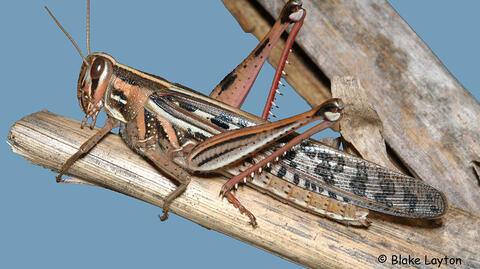Bug’s Eye View
American Grasshopper, No. 25

Order: Orthoptera
Family: Acrididae
American grasshoppers are also known as American bird locusts. If you happen to flush one when walking through a field this fall, they may not just hop a few feet in front of you like most grasshoppers. Instead, they may take wing, fly several hundred feet, and land in a high tree. Although these large grasshoppers have two generations a year, they are most abundant in the fall. Mature females are approximately 2 inches in length, and the males are only slightly smaller. While most grasshoppers overwinter as eggs in the soil, American grasshoppers overwinter as adults, and lethargically active adults can be spotted on warm winter days in meadows and along wooded edges throughout the winter.
Although they feed on a wide variety of plants, American grasshoppers are not major pests, at least not here in Mississippi. Occasionally, populations build to outbreak levels and such outbreaks can cause significant plant injury if not controlled. However, outbreaks of this type occur more commonly in Florida. When American grasshoppers are pests here in Mississippi, they usually occur in combination with a complex of several other species of grasshoppers to cause damage to sensitive crops such as vegetables or ornamental plants, and damage is often concentrated along field edges.
As the “locust” part of the name suggests, the American bird locust is “related” to the desert locust of Africa and Middle Eastern countries, which occasionally builds to plague-level populations and migrates in huge swarms containing hundreds of millions of grasshoppers. The last big outbreak of this nature occurred approximately ten years ago in West Africa, but smaller outbreaks have occurred since. The desert locust, Schistocerca gregaria, which is likely one of the species of locusts mentioned in the Bible, belongs to the same genus as our American grasshopper, but fortunately, American grasshoppers never enter a plague-level migratory phase like the desert locust. Here in the US, the Rocky Mountain locust, Melanoplus spretus, used to occur in plague-level outbreaks, reaching populations estimated to be in the trillions and causing widespread devastation to early western settlers, but, like Passenger Pigeons, Rocky Mountain locusts are now extinct. We have other species of Melanoplus grasshoppers here in the state, but fortunately, like the American grasshopper, they never enter a plague-level migratory phase.